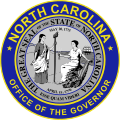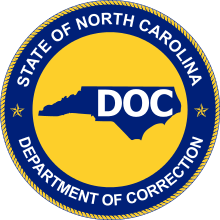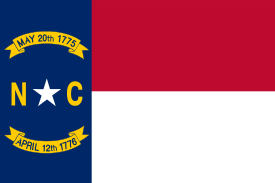Seal of North Carolina
The Great Seal of the State of North Carolina was first authorized by the North Carolina Constitution of 1776, created in its first form in 1778, and largely took on its modern form in 1835. According to a state law passed by the North Carolina General Assembly in the 1971 ad modified in 1983:[1][2]
"The Governor shall procure of the State a Seal, which shall be called the great seal of the State of North Carolina, and shall be two and one-quarter inches in diameter, and its design shall be a representation of the figures of Liberty and Plenty, looking toward each other, but not more than half-fronting each other and other-wise disposed as follows: Liberty, the first figure, standing, her pole with a cap on it in her left hand and a scroll with the word "Constitution" inscribed thereon in her right hand. Plenty, the second figure, sitting down, her right arm half extended toward Liberty, three heads of grain in her right hand, and in her left, the small end of her horn, the mouth of which is resting at her feet, and the contents of the horn rolling out." "The background on the seal shall contain a depiction of mountains running from the left to the right to the middle of the seal. A side view of a three-masted ship shall be located on the ocean and to the right of Plenty. The date "May 20, 1775" shall appear within the seal and across the top of the seal and the words "esse quam videri" shall appear at the bottom around the perimeter. No other words, figures or other embellishments shall appear on the seal."
| Great Seal of the State of North Carolina | |
|---|---|
 | |
| Versions | |
.svg.png) Seal of 1971-1984 | |
.jpg) Historical coat of arms (illustrated, 1876) | |
| Armiger | State of North Carolina |
| Adopted | 1971, officially (most recent change in 1984) |
| Motto | Esse quam videri |
The date of May 20, 1775, refers to the Mecklenburg Declaration of Independence, allegedly the first declaration of independence adopted during the American Revolution.
The motto "Esse quam videri" means "To Be Rather Than To Seem." The "pole with a cap" is a liberty pole.
History
In 1971, the seal was officially standardized after the state's chief deputy attorney general discovered that there was more than one version in use.[3] In 1983, state senator Julian R. Allsbrook proposed a revision to the seal to add to the seal the date April 12, 1776, the date of the Halifax Resolves; this revision was approved by the state legislature.[4] These two dates are also on the flag of North Carolina.[5][6]
Government seals of North Carolina
 Seal of the Governor of North Carolina
Seal of the Governor of North Carolina Seal of the Attorney General of North Carolina
Seal of the Attorney General of North Carolina Seal of the North Carolina Department of Correction
Seal of the North Carolina Department of Correction Seal of the North Carolina Department of Transportation
Seal of the North Carolina Department of Transportation- North Carolina seal on plaque of monument to Major Joseph Winston, Guilford Courthouse National Military Park, Greensboro, North Carolina
References
- Connor, R.D. W. (1921). North Carolina Manual, 1921.
- Eure, Thad, ed. (1967). North Carolina Manual, 1967. p. 37.
- "One Man's Tale of The Great Seal of North Carolina". biandgrain.com. Retrieved December 27, 2019.
- "North Carolina Bar Examines Halifax Resolves". Roanoke Rapids Daily Herald.
- Williams, Wiley J. (2006). "State Seal". NCPedia. Retrieved November 8, 2019.
- Thompson, Jessica Lee. "The Great Seal of the State of North Carolina". NorthCarolinaHistory.org. Retrieved December 27, 2019.
- "Seals used after independence". Retrieved December 27, 2019.
- The old north state fact book. Raleigh: North Carolina office of archives and history. 2008.
- Grimes, Bryan (revised by D.L. Corbitt) (1966). The History of the Great Seal of the State of North Carolina. State Department of Archives and History.
- Lewis, J.D. "North Carolina State Seal History". carolana.com.
.svg.png)
